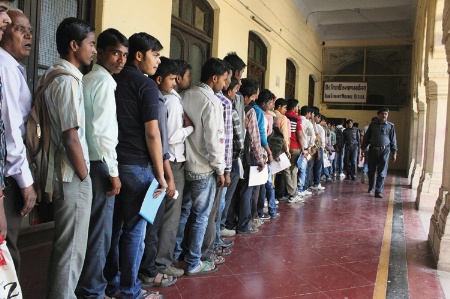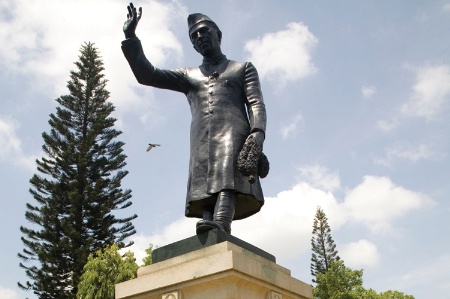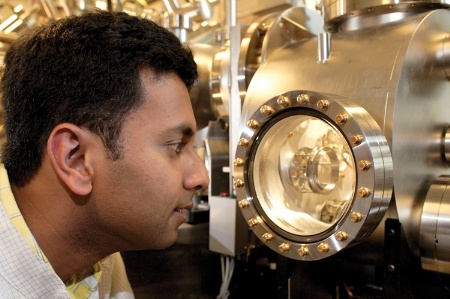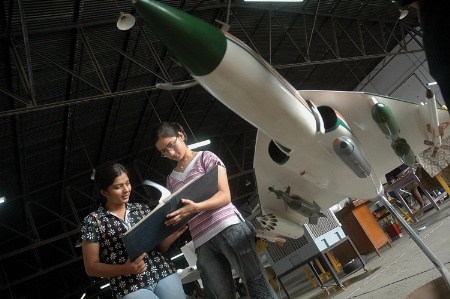In a growing country of 1.2 billion people, home to a third of the world’s poorest, education - or the lack of it - can make an enormous difference to people’s lives
It is a hot Wednesday night in New Delhi and the Rajasthan Royals are taking on the Sunrisers Hyderabad in the Indian Premier League - the world’s richest cricket tournament.
Every time a Royals batsman - stars including Rahul Dravid and Shane Watson among them - turns away from the television cameras, the back of his helmet reveals the name of the team’s “official knowledge partner”, Amity University, to tens of millions of Indians watching the play-off at home. In the midst of a full-on advertising assault from providers of smartphones, financial products and cement, the private university’s brand holds its own, also flashing up regularly in the corner of the TV screen right next to the score.
Meanwhile, the front page of The Times of India, the nation’s most popular English-language newspaper, is dominated by higher education. There is a story about students who had to race across Delhi to sit their papers after being locked out of their university’s examination venue, plus adverts for private institutions GD Goenka University and Lovely Professional University, the latter welcoming Shri Pranab Mukherjee, India’s president, to its third graduation ceremony. Page three features an article about the University of Delhi’s controversial switch to four-year degrees, two more adverts for private institutions and a public notice from Amity stating that it “does not accept donations/capitation fees for admissions…If anyone makes such a demand, kindly report immediately” - a reference to the widely frowned-upon (but prevalent) practice of students and parents being forced to pay a sum that is not advertised in the prospectus in exchange for a university place at a private institution.
It is clear that higher education is high on the agenda in India, the world’s largest democracy. In a growing country of 1.2 billion people, home to a third of the world’s poorest, education - or the lack thereof - can make an enormous difference to people’s lives and is the subject of intense competition.
Faced with this growing appetite for learning, the Indian Planning Commission’s 12th Five Year Plan - the nation has been committed to socialist-style central planning since independence - has set a target to create capacity for an extra 10 million students over the next five years on top of the existing 25.9 million in the system in 2011-12.
India’s economic growth is slowing - gross domestic product increased by 5 per cent in 2012, down from a peak of 9 per cent in 2007. The commission expects higher education to do some heavy economic lifting, and demands job-ready graduates and research universities with global status. Over the next five years, it says, “an overriding emphasis will be given to quality - as further expansion without quality improvement would be counterproductive for the future of India”.
But plenty of governments aspire to such goals. Is India doing anything more than dreaming?
Even by the standards of India’s chaotic roads, on which hooting your horn every 20 seconds or so is seemingly obligatory, Bangalore’s traffic jams are something special. They are the product of exceptionally fast population growth in the city: it expanded by nearly 50 per cent between 2001 and 2011 and is now home to almost 10 million people. This rapid increase has been driven in large part by Bangalore’s information technology boom, led by businesses such as the multinational Infosys, one of India’s largest publicly traded companies. Large numbers of wealthy young IT professionals live in the city, which is also favoured by entrepreneurs. The roadside hoardings advertising luxury apartments are aimed at them, including one that cuts to the chase: “Where you live says who you are.”
One of the city’s most notable graduate employers is Shell, which has based one of its three global technology centres in Bangalore (the others are in Houston and Amsterdam). The centres are core to the company’s worldwide research and development operation - and Shell says it came to India for the graduate talent. But this does not mean that there is no room for improvement.
Hugo Vits, Shell’s site manager, says that meeting India’s economic ambitions of 8 per cent growth a year will require talent “coming out at different levels - from the very high end to the vocational”. He suggests that while there has been “quite a bit of attention and recognition of the high-end talent, such as the Indian Institutes of Technology”, there needs to be more focus on the latter.
He also wants to see the “development of soft skills” among Indian students.
“If you look at the typical high-end Indian engineer, he’s absolutely amazing in terms of his mathematical delivery - the ability to really go down to the formulae and get them to work for you,” Vits observes, but adds: “It looks as if people are still very much focused on delivering exams.”
The Planning Commission’s analysis of higher education in the latest Five Year Plan, published in draft form in February, is frank about the Indian academy’s shortcomings.

While government rules require all private institutions to be not-for-profit, some believe this rule should be changed to encourage entrants. This would be a hugely controversial move
“The sector is plagued by a shortage of well-trained faculty, poor infrastructure and outdated and irrelevant curricula,” it says. It also argues that there is a “lack of research orientation, even in the best of Indian institutions”; and that the number of PhDs produced in science and engineering is “minuscule” compared with China and the US.
Does this tally with how things look to people on the ground in some of India’s major higher education institutions?
Jawaharlal Nehru University in New Delhi is named after the nation’s first prime minister, whose statue stands watch over the campus, along with some spectacular murals daubed on the walls by left-wing students. The central government university, one of the nation’s leading institutions, has a distinctive mission: its official “particulars” state that it “draws students from every nook and corner of the country and from every group and stratum of society, ensuring representation of underprivileged and weaker sections”.
Like the Planning Commission, Alok Bhattacharya, a professor in JNU’s School of Life Sciences and vice-president of the Indian National Science Academy, is trenchant in his criticism of the Indian higher education system. He laments the “pathetic level of grants” in research, the rigidity of curricula and their lack of scope for problem-solving, as well as inflexibility in salary and promotion structures, which are mostly uniform across central government institutions.
While one of JNU’s “major achievements” is its affirmative-action admissions policy for students from disadvantaged castes, tribes and classes (it introduced this before other Indian institutions), Bhattacharya cautions that “just because they are coming from that kind of background doesn’t mean they shouldn’t get world-class education. We should keep our inclusivity but provide world-class education.”
At the public University of Pune, visiting the vice-chancellor is like stepping back to the days of the Raj. Wasudeo Gade’s offices are in a building constructed as the residence of the governors of Bombay that stands next to a flaming red gulmohar tree. Gade recounts that construction of the building in the 1860s prompted questions in Westminster over the exorbitant cost.
For Gade, the key issue facing India’s sector is the continuing rise in student numbers. “Where are the faculty members to teach them? In India at the moment, the biggest challenge is getting adequate numbers of qualified faculty,” he says.
The solution? Wade argues for more international collaborations and greater use of technology as a way to expose Indian students (and academics) to expert teaching.
There is also concern that some of India’s best-qualified graduates have left the country, many ending up in the US. The extent of the problem is outlined by Anurag Sharma, dean of academics and professor of physics at the Indian Institute of Technology, Delhi. In 2005, he says, the US Congress passed a resolution praising the IITs. What made this notable is that the “Indian Parliament has not passed a resolution like that, but the US has”. It recognises “that Silicon Valley is mostly infested with IITians”, he explains.
Sharma says that IIT Delhi is looking to boost the number of doctorates it produces each year from 0.4 per faculty member to 1. But, he adds, this may not be enough to keep up with India’s key competitors.

Meeting India’s economic ambitions will require talent ‘coming out at different levels - from the very high end to the vocational’ and there needs to be more focus on the latter
“If you look at China, it is doing more than this,” he says, noting that “industry in India is not really employing PhDs in great numbers”.
Faced with a rigid state sector and a shortage of academic staff, how will the Planning Commission’s target of 10 million extra enrolments in the next five years be met? Unsurprisingly for an academy in which private providers account for 59 per cent of enrolments, the commission expects them to deliver “the bulk of growth”.
While tuition fees in public institutions are usually very low - the prestigious St Stephen’s College in Delhi charges Rs22,435 (£248) a year, for example - private students face much higher charges. Amity says it charges up to Rs300,000 a year for some courses. (Fees at the central government IITs are rising to Rs90,000 for the coming academic year, up from Rs50,000.)
While government rules require all private institutions to be not-for- profit, some believe this rule should be changed to encourage entrants. This would be a hugely controversial move.
Atul Chauhan is the chancellor of Amity, India’s first private university and the source of that formidable IPL advertising campaign. Of the adverts he says: “In education, it is all about feeling pride, feeling part of a family - and people around you feeling proud of where you are…That’s why we did it.”
Chauhan argues that there is greater scope than at public peers for creating innovative courses at private bodies such as Amity, which teaches a wider range of subjects - including India’s first degree programme in nanotechnology.
But he warns that there are problems in the private sector, too, a major one being the widespread acceptance of capitation fees.
Chauhan calls such payments “illegal and unethical”, and says that “99.9 per cent of people [in the private sector] are taking money under the table”.
One person looking to seize the opportunity for expansion is Pramath Raj Sinha. Founding dean of the private Indian Business School, Sinha is now establishing Ashoka University, a private institution that aims to be “a bit like a small liberal-arts university in the US”.
A former partner at global management consultancy McKinsey, Sinha pinpoints the non-profit rule as a major impediment to private sector growth. He also says that while the rules prevent equity investments or buy-outs, many university owners are effectively deriving profits by paying themselves big money. This “creates a bit of a grey area”, he says, but “if there are investors who would like to put money into education, the structures don’t exist”.

Sinha suggests that the rules should be changed, so that while private institutions should still not be allowed to profit directly from students, money could be derived from the provision of services or in other ways.
In its draft plan, the Planning Commission suggests that “the not-for- profit status in higher education should, perhaps, be re-examined for pragmatic considerations so as to allow the entry of for-profit institutions in select areas where acute shortages persist”.
Chauhan is strongly opposed to any such move, however. “If it becomes for- profit then people will start looking for short-term benefits for shareholders,” he warns.
The same concerns about profiting from education have dogged another long- running debate over whether foreign universities should be allowed to set up campuses in India. Some view this as another possible solution to the shortage of places and a potential way of raising standards. However, a bill regulating foreign providers, which would bar them from taking profits out of the country, has long been stalled in Parliament.
For Sinha, the bill is a “big red herring” and, if implemented, would be more likely to restrict the operation of foreign universities than to facilitate their entry. He points out that partnerships and collaborations between Indian and foreign institutions, allowing the latter to operate in the country but not award their own degrees, are already permissible.
Western universities are experiencing funding shortfalls and the number of young people in their host countries is declining, while India is experiencing a demographic bulge and greater numbers of young people than ever. In this context, it would make sense for “all the great Western universities” to educate “large numbers of Indians”, Sinha thinks.
Could Western universities have a future as private institutions in India? “Absolutely. This is a great source of revenue and funding for them,” he says.
Elsewhere, India is looking to boost its science base. While the buildings and laboratories at even prestigious Indian institutions can appear shabby compared with Western universities, at the Indian Institute of Science Education and Research Pune, the buildings are brand new and the labs stunning.
The institution, established in 2006, is one of five designed to drive up national standards in basic science. In a country notorious for foot- dragging bureaucracy, the creation of the IISER quintet is said to have been personally pushed through in double-quick time by Prime Minister Manmohan Singh, a former academic economist with an undergraduate degree from the University of Cambridge and a DPhil from the University of Oxford.
L.S. Shashidhara, professor and coordinator in biology at IISER Pune, explains that after independence, India’s “main emphasis was on technical education because we wanted to improve our infrastructure”. But, he adds, in the process of developing this area and “providing services to the world, we sort of neglected basic science”.

Just as the IITs have “produced leaders in the industry of technology, inside and outside India”, Shashidhara says, “we want IISERs to be role- model institutes that will produce the next generation of leaders of science”.
The five institutions offer undergraduate research-based training in basic science. And the students have to be superb to gain entry - they need to finish in the top 1 per cent of the national High School Leaving Certificate just to be eligible to take the entrance test.
But there is frustration in India that the quality of its best institutions is not yet recognised globally. Speaking privately, one IISER Pune faculty member tells a story that highlights the lack of understanding. He worked as a postdoctoral researcher at a leading US university and left with more than a dozen publications in English- language journals to his name. Just before he departed, his US supervisor asked if he would be teaching in Hindi when he returned to India, thus failing to grasp that teaching in English is widespread across Indian higher education.
He felt like asking his supervisor: “How do you think I published 14 papers? Did you teach me English?”
The Planning Commission has some solutions in mind for Indian higher education. To create “globally competitive research-intensive institutions”, it recommends increasing investment in research from 1 per cent of GDP to 2 per cent and concentrating research funding “in high potential institutions and faculty through competition”.
Regarding funding in the government sector, it says that fee rises like those seen at the IITs “should be continued” and “cover all government institutions”. To support non-profit private providers, the commission says that public student financial aid could be extended to them if they sign up to accreditation - a move it hopes will simultaneously raise quality.
But while the Planning Commission may have Singh, the prime minister, as its chair, the government may not want to - or be able to - implement its recommendations. Parliament is notoriously unwieldy, with an array of smaller parties in the governing United Progressive Alliance coalition alongside the Congress Party.
In one recent disappointment, the National Council for Higher Education and Research bill, which would have created a single regulator by merging bodies such as the University Grants Committee and the All India Council for Technical Education, was dropped by the government in June after it got stuck in Parliament. Many had expected the bill to streamline the sector and give universities greater autonomy.
Speaking at a British Council conference and roundtable in Delhi earlier this year, Shashi Tharoor, minister of state in the Ministry of Human Resource Development, said that the government had an excellent bill that aimed to “create 14 universities specifically for research and innovation”, but went on to offer a familiar lament: “The blessed thing still hasn’t got through Parliament.”
So, while the planners have their dreams - and in a few places such as the IISERs, these may be on their way to being realised - the reality is an unwieldy higher education system that is difficult to reform. State governments, of a wide variety of political persuasions, control many universities and their priorities may differ radically from those of the central government. Meanwhile, the failings of the schools system - split between government schools for the poorest and private schools for the rest - mean that higher education remains out of reach for many. As the politicians wrangle and debate, the future of millions of young Indians hangs in the balance.
Complex sums: India’s higher education sector in numbers
Student numbers
India’s overall enrolment figure for 2011-12 is 25.9 million. Target enrolment for 2016-17 is 35.9 million.
Participation
The Indian government measures gross enrolment rate (GER), the proportion of the total 18-23 age cohort in higher education. According to this, GER in 2011-12 was 17.9 per cent, compared with a global average of 26 per cent. India’s target for 2016-17 is a rate of 25.2 per cent.
Indian higher education institutions
India has 46,430 higher education institutions, comprising central government, state government and private institutions.
- There are 221 central government institutions, accounting for 2.6 per cent of enrolment.
- Forty of these are central government universities such as the Central University of Karnataka or the universities of Delhi and Hyderabad.
- There are 15 Indian Institutes of Technology, best known for high quality undergraduate education in applied science and engineering. The first, IIT Kharagpur, was established as an IIT in 1951.
- The 13 Indian Institutes of Management offer postgraduate education in management. The first - IIM Calcutta and IIM Ahmedabad - were established in 1961 and the most recent were created in 2011.
- The five Indian Institutes of Science Education and Research were set up to improve the quality of India’s basic science. The first - IISER Kolkata and IISER Pune - were established in 2006.
- There are 16,547 state institutions, including 316 state universities, which account for 38.5 per cent of enrolment. Mumbai, Madras and Calcutta, established in 1857, are the oldest state universities.
- There are 13,024 colleges. These do not have the power to award their own degrees. Curricula are taken from the state universities, which maintain a high degree of control over courses.
- There are also 3,207 state diploma institutions.
- The 29,662 private institutions account for 58.9 per cent of enrolment. Of these, the 191 private universities have the power to award their own degrees. The first such institution, Amity University, now has five separate campuses across India. Lovely Professional University is another of the largest private universities.
- There are also 19,930 private colleges and 9,541 private diploma institutions.
Source: 12th Five Year Plan (2012-2017), Planning Commission (Government of India)
Register to continue
Why register?
- Registration is free and only takes a moment
- Once registered, you can read 3 articles a month
- Sign up for our newsletter
Subscribe
Or subscribe for unlimited access to:
- Unlimited access to news, views, insights & reviews
- Digital editions
- Digital access to THE’s university and college rankings analysis
Already registered or a current subscriber?
